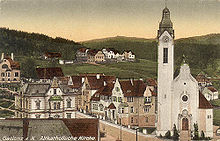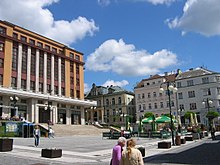Jablonec nad Nisou
Jablonec nad Nisou | |
|---|---|
 Dolní Square | |
|
| |
| Coordinates: 50°43′28″N 15°10′5″E / 50.72444°N 15.16806°E | |
| Country | |
| Region | Liberec |
| District | Jablonec nad Nisou |
| First mentioned | 1356 |
| Government | |
| • Mayor | Miloš Vele (ODS) |
| Area | |
| • Total | 31.38 km2 (12.12 sq mi) |
| Elevation | 475 m (1,558 ft) |
| Population (2024-01-01)[1] | |
| • Total | 46,226 |
| • Density | 1,500/km2 (3,800/sq mi) |
| Time zone | UTC+1 (CET) |
| • Summer (DST) | UTC+2 (CEST) |
| Postal code | 466 01 |
| Website | www |
Jablonec nad Nisou ([ˈjablonɛts ˈnad ɲɪsou] ; German: Gablonz an der Neiße) is a city in the Liberec Region of the Czech Republic. It has about 46,000 inhabitants. It is the second-largest city in the region. It is a local centre for education, and is known for its glass and jewelry production, especially for bijou. The historic town centre is well preserved and is protected by law as an urban monument zone.
Administrative division
[edit]Jablonec nad Nisou is made up of eight city parts: Jablonec nad Nisou, Jablonecké Paseky, Kokonín, Lukášov, Mšeno nad Nisou, Proseč nad Nisou, Rýnovice and Vrkoslavice.[2]
Etymology
[edit]The name Jablonec is of Czech origin and means 'little apple tree' (jablonče was a diminutive of the old Czech jabloň – 'apple tree'), for the village was founded on a place where an apple tree grew. German-speaking settlers who came to the village during the 16th century adjusted the name to Gablonz. During the 19th century, the attribute "German" was often added to the name (like in the 1848 Jablonec německý, German: Deutsch-Gablonz). In 1904, the official attribute in both Czech and German became 'on the Neisse', which described the location of the city upon the Lusatian Neisse River.[3]
Geography
[edit]
Jablonec nad Nisou is located about 7 km (4 mi) southeast of Liberec and 83 km (52 mi) northeast of Prague. Most of the built-up area lies in the eastern tip of the Zittau Basin, and it is surrounded with the Jizera Mountains in the north, east and south. The northern part of the municipal territory also belongs into the Jizera Mountains Protected Landscape Area. The highest point of Jablonec nad Nisou is located on the slopes in the southeastern part of the territory, with an altitude of 758 m (2,487 ft).
Jablonec nad Nisou is situated at the confluence of the rivers Lusatian Neisse and Bílá Nisa. The Mohelka River originates in Jablonec nad Nisou-Kokonín. The Mšeno Reservoir in the city belongs to the largest inner city areas in Europe. It was built in 1906–1909 and has an area of around 42 ha (100 acres).[4][5]
History
[edit]
The first written mention of Jablonec was in a Latin document from 1356 as Jablonecz. According to this document, Jablonec was founded in the 14th century. In August 1469, the village was burned to the ground by troops of rebelling Lusatians in the war between them and King George of Poděbrady. The village was then resettled in the 1530s and 1540s by mostly German-speaking colonists.[3][6]
In the first half of the 17th century, Jablonec was owned by Albrecht von Wallenstein, who sold it to the Desfours family. In 1643, during the Thirty Years' War, Jablonec was burned down for the second time. Glass production began to flourish in the second half of the 17th century and Jablonec began to develop rapidly. In the 18th century, the first bijou was produced and the first exporter, J. F. Schwann, spread the villages's name throughout Europe. Jablonec was promoted to a market town by Emperor Francis II on 21 April 1808.[6]
Further development followed the construction of the road in the 1840s. Jablonec was then promoted to a town by Emperor Franz Joseph I on 28 March 1866. Franco-Prussian War in 1870–1871 damaged competitors in the production of glass and jewelry, and the Jablonec traders seized the foreign markets. A steady supply of a wide range of glass and artificial jewellery products flowed out of the town. This industrial advancement also improved the quality of life, and Jablonec's appearance changed dramatically.[6]
Historian Peter Hinks, writing about the various types of Late Victorian jewellery sold by British and American companies at the turn of the 20th century, noted that "The Bohemian garnet jewellery sold by Moore and Evans [in Chicago] was the product of an industry based in the town of Gablonz, now Jablonec. These very effective jewels were set with locally mined garnets, rose cut and set in gold mounts of very formal design."[7]
However, the worldwide economic crisis resulting from the Wall Street Crash of 1929 damaged the glass and jewellery industry and the crisis of the 1930s. Changing trends and the growth of foreign competition also hurt the local industry. In October 1938, Jablonec was annexed to Nazi Germany after the Munich Agreement, and was administered as a part of Reichsgau Sudetenland until 1945.[6]
Between 1945 and 1949, most of the Germans were expelled under the terms of Beneš decrees. After the war, the expelled German-speaking citizens of Jablonec founded a new settlement in Bavaria and called in remembrance of their hometown Neugablonz ("New Jablonec"). Today, it is one of the districts of the city of Kaufbeuren.[8]
Demographics
[edit]
|
|
| ||||||||||||||||||||||||||||||||||||||||||||||||||||||
| Source: Censuses[9][10] | ||||||||||||||||||||||||||||||||||||||||||||||||||||||||
Economy
[edit]Jablonec nad Nisou holds the Czech Mint after Czechoslovakia split into the Czech Republic and Slovakia (the Czechoslovak mint, also known as the Kremnica Mint, is now in Slovakia).
The city has a long tradition of costume jewelry and beads production.
The biggest industrial employers with headquarters in the city are Preciosa (glass products manufacturer) are TI Automotive AC (production of car air conditioners).[11]
The Liberec-Jablonec agglomeration was defined as a tool for drawing money from the European Structural and Investment Funds. It is an area that includes the cities of Liberec and Jablonec nad Nisou and their surroundings, linked to the cities by commuting and migration. It has about 227,000 inhabitants.
Transport
[edit]Jablonec nad Nisou shares the tramway line which connects it to its neighbouring city of Liberec.
The city is located on the railway line from Liberec to Szklarska Poręba. The territory is served by four stations and stops.
Sport
[edit]Jablonec has a swimming pool, three football and athletic stadiums, and an ice hockey arena.
The city is represented by FK Jablonec in the Czech First League. The club has been a stable member of the league since 1994.
Before the World War II, a number of ethnic German football clubs existed in Gablonz, Fortuna, DSK and BSK. These were merged into NSTG Gablonz in 1939 by the Nazis, NSTG standing for Nationalsozialistische Turngemeinde. NSTG played in the Gauliga Sudetenland but disappeared with the end of the war.[12] BSK however was reformed in 1950 in Bavaria, under the name of BSK Neugablonz.[13]
Sights
[edit]
The historical city centre is formed by squares Dolní, Mírové, Horní, and Anenské, which lies close to each other, and their surroundings. The Old Town Hall with a typical square tower was built on Dolní Square in 1867–1869. Today it serves as a library.[14]
The current city hall is called New Town Hall and is located on Mírové Square. It is a functionalistic building, built in 1930–1933. It is an excellent example of interwar modern architecture. For its value, it has been protected as a national cultural monument since 2024.[15]
There are several churches in the city: Church of Saint Anne (built in the Baroque style in 1865–1867), Church of the Most Sacred Heart of Jesus (a brick building, built 1930–1931), Church of the Exaltation of the Holy Cross (built in the Art Nouveau style in 1900–1902; one of the most important sacral Art Nouveau buildings in Europe), and Protestant Dr. Farský Church (a pseudo-Gothic building from 1892).[14]
The tradition of costume jewellery production is presented in the Museum of Glass and Costume Jewellery. It was founded in 1904 and it is located in an Art Nouveau building.[14]
Notable people
[edit]- Adolf Benda (1845–1878), historian
- Gustav Leutelt (1860–1947), writer and poet
- Reinhold Hanisch (1882–1937), business partner of Adolf Hitler in Vienna, 1910
- Konrad Henlein (1898–1945), Nazi politician
- Peter Herman Adler (1899–1990), conductor
- Ute de Lange Nilsen (1931–2024), Czech-Norwegian artist
- Jiří Moskal (born 1949), rally raid driver
- Ivan Bartoš (born 1980), politician
- Jakub Čutta (born 1981), ice hockey player
- Barbora Špotáková (born 1981), javelin thrower
- Radka Vodičková (born 1984), triathlete
- Daniel Špaček (born 1986), ice hockey player
- Gabriela Koukalová (born 1989), biathlete
- Jessica Jislová (born 1994), biathlete
- Markéta Davidová (born 1997), biathlete
Twin towns – sister cities
[edit]Jablonec nad Nisou is twinned with:[16]
 Bautzen, Germany
Bautzen, Germany Beihai, China
Beihai, China Jelenia Góra, Poland
Jelenia Góra, Poland Kaufbeuren, Germany
Kaufbeuren, Germany Marsciano, Italy
Marsciano, Italy Ronse, Belgium
Ronse, Belgium Zwickau, Germany
Zwickau, Germany
References
[edit]- ^ "Population of Municipalities – 1 January 2024". Czech Statistical Office. 2024-05-17.
- ^ "Části obcí". Územně identifikační registr ČR (in Czech). Retrieved 2023-11-14.
- ^ a b Lutterer, Ivan; Majtán, Milan; Šrámek, Rudolf (1982). Zeměpisná jména Československa (in Czech). Prague: Mladá fronta. p. 129.
- ^ "Přehrada Mšeno v Jablonci nad Nisou" (in Czech). CzechTourism. Retrieved 2022-11-06.
- ^ "Přehrada Mšeno" (in Czech). Ceskehory.cz. Retrieved 2022-11-06.
- ^ a b c d "Z Jablonce do Neugablonz aneb Jak si tisíce sudetských Němců postavilo nový domov" (in Czech). City of Jablonec nad Nisou. Retrieved 2023-04-04.
- ^ Hinks, Peter (1991). "Introduction". Victorian Jewellery. London: Studio Editions. ISBN 9781851706396.
- ^ "Z Jablonce do Neugablonz aneb Jak si tisíce sudetských Němců postavilo nový domov" (in Czech). Czech Radio. 2023-02-15. Retrieved 2023-04-04.
- ^ "Historický lexikon obcí České republiky 1869–2011" (in Czech). Czech Statistical Office. 2015-12-21.
- ^ "Population Census 2021: Population by sex". Public Database. Czech Statistical Office. 2021-03-27.
- ^ "Registr ekonomických subjektů". Business Register (in Czech). Czech Statistical Office. Retrieved 2024-10-20.
- ^ Grüne, Hardy (2001). Vereinslexikon. Kassel: AGON Sportverlag ISBN 3-89784-147-9
- ^ "Historie - Chronik des BSK Olympia" (in German). BSK Neugablonz. 2011-07-18. Archived from the original on 2011-07-18.
- ^ a b c "Places of Interest". City of Jablonec nad Nisou. Retrieved 2021-08-11.
- ^ "Nová radnice" (in Czech). National Heritage Institute. Retrieved 2024-03-27.
- ^ "Partnerská města" (in Czech). City of Jablonec nad Nisou. Retrieved 2020-06-22.
External links
[edit]- Official website
- Official tourist portal
- Old postcards (in German)




